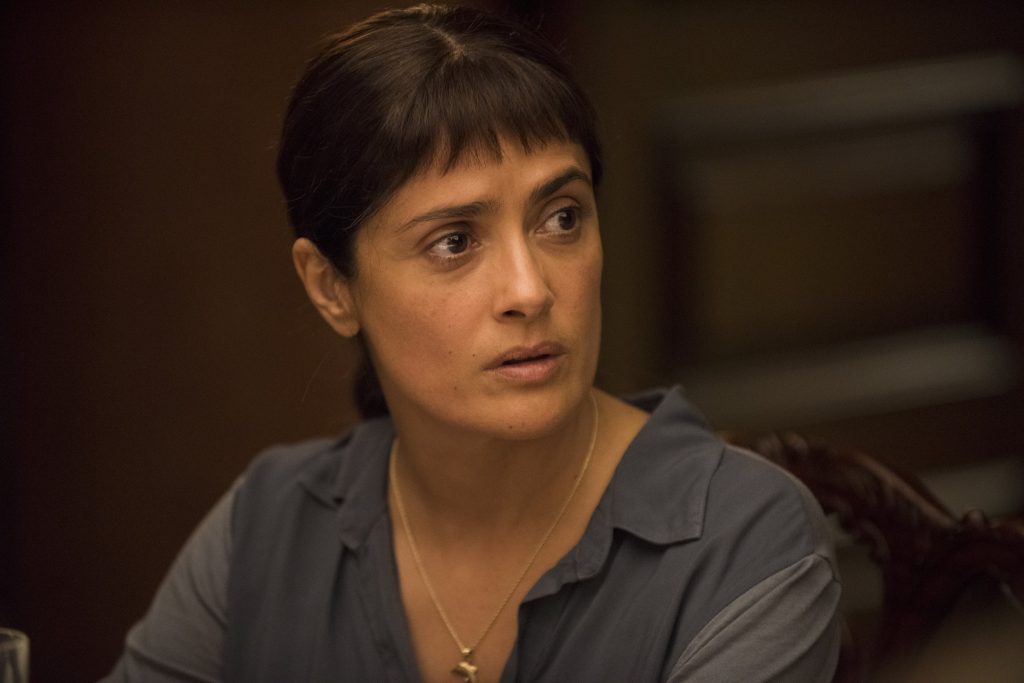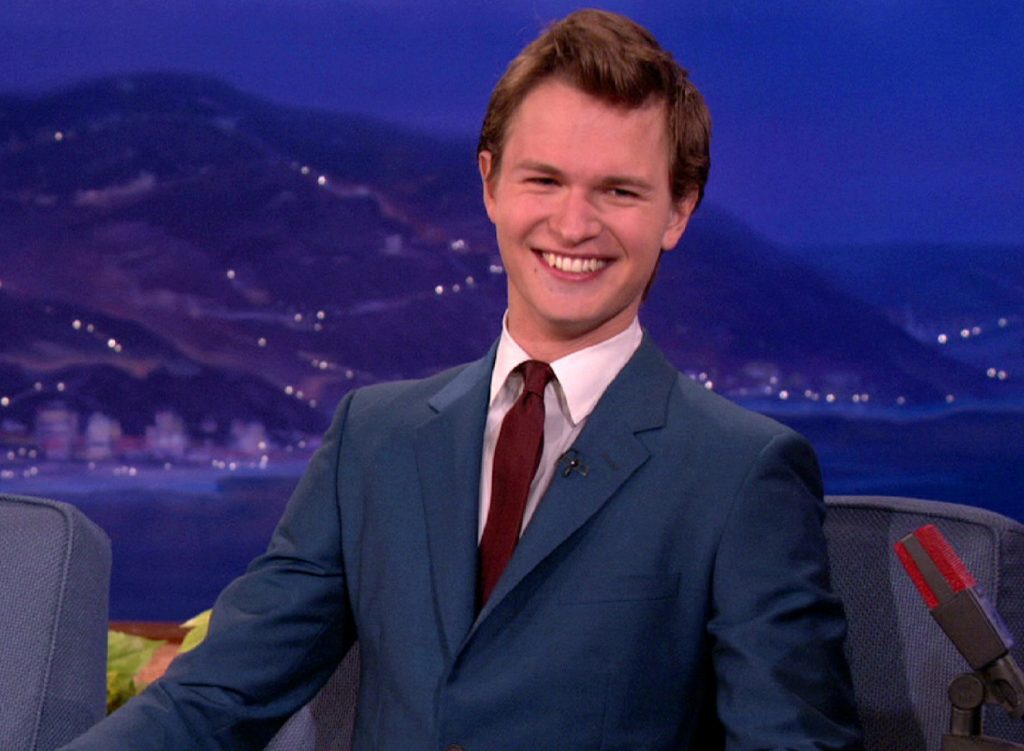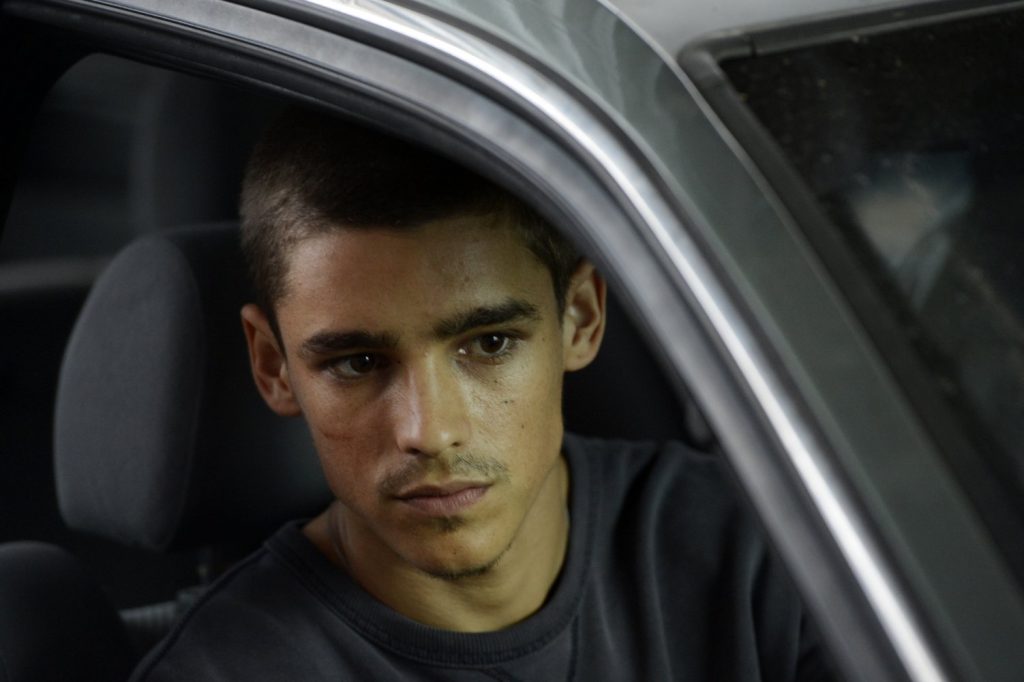December 2, 2021
by Carla Hay

Directed by Steven Spielberg
Some language in Spanish with no subtitles
Culture Representation: Taking place in 1957 in New York City, the musical drama remake “West Side Story” features a cast of white and Latino people representing the working-class.
Culture Clash: A young Puerto Rican woman and a young Polish American man fall in love with each other, despite having people close to them who are in rival, warring gangs that are opposed to this romance.
Culture Audience: Besides the obvious target audience of fans of the original “West Side Story” movie musical, this 2021 version of “West Side Story” will appeal primarily to people who are fans of director Steven Spielberg and movie adaptations of Broadway musicals.

The 2021 remake of “West Side Story” is exactly the glossy spectacle that you might expect from director Steven Spielberg. The movie is a bonafide crowd-pleasing epic that makes some interesting changes from the 1961’s “West Side Story” movie, a classic that was directed by Jerome Robbins and Robert Wise. In the 2021 version of “West Side Story,” some of these changes work better than other revisions to the original movie. The original “West Side Story” movie was based on a Tony-winning musical that debuted on Broadway in 1957. The Broadway musical was written by Arthur Laurents, with music by Leonard Bernstein and lyrics by Stephen Sondheim. Ernest Lehman wrote the screenplay to the 1961 “West Side Story,” while Tony Kushner wrote the screenplay to the 2021 “West Side Story.”
The original “West Side Story” movie starred Natalie Wood, Richard Beymer, Rita Moreno and George Chakiris as four young people in New York City who are caught in the middle of gang warfare, ethnic bigotry and risky romance. Moreno and Chakiris won Oscars for their supporting roles in the movie, which won a total of 10 Oscars, including Best Picture. (Moreno’s Oscar victory was groundbreaking, as she became the first Latina to win an Academy Award.) Is the 2021 version of “West Side Story” worthy of 10 Academy Awards? No, but there are some standout performances that should bring more attention to some very talented cast members. They do all their own singing, unlike some of the stars of the original “West Side Story” movie.
Most fans of musicals already know the basic premise of “West Side Story,” which is set in New York City (specifically, in a working-class area of Manhattan’s West Side) in 1957. It’s a story inspired by William Shakeapeare’s “Romeo and Juliet.” In “West Side Story,” a sweet and innocent Puerto Rican woman named Maria, who’s in her late teens, falls in love with a slightly older, streetwise Polish American man named Tony, who is an ex-con trying to start a new and reformed life away from an all-white gang that he used to lead called the Jets. Maria’s domineering older brother Bernardo is the leader of an all-Puerto Rican rival gang called the Sharks. Bernardo is dating Maria’s sassy best friend Anita. Needless to say, the romance of Maria and Tony sparks a war between the Jets and the Sharks.
In the original “West Side Story” movie, Wood was Maria, Beymer was Tony, Moreno was Anita and Chakiris was Bernardo. In the 2021 “West Side Story” remake (which also takes place in 1957), Rachel Zegler is María, Ansel Elgort is Tony, Ariana DeBose is Anita and David Alvarez is Bernardo. Unlike the original “West Side Story” movie, Spielberg’s “West Side Story” remake avoids any criticism of “whitewashing” racial casting, by casting the people of color characters with actors who are also people of color. Zegler is a Latina of Colombian heritage. DeBose is multiracial; in interviews, she sometimes identifies herself as African American. (DeBose’s father is Afro-Latino, and her mother is white.)
Perhaps the biggest and best change to the “West Side Story” remake is the clever idea to cast original “West Side Story” movie co-star Moreno in the role of a new character: Valentina, the no-nonsense but kind-hearted owner of a drugstore called Doc’s Chemists, where Tony works. In this version of “West Side Story,” Valentina is the widow of Doc, the store’s owner in the original “West Side Story” movie. (Doc was played by Ned Glass.) Considering all the racial discord in the story, the Valentina character gives the movie added poignancy because a Latina woman has given Tony a chance to redeem himself and start a new life.
Valentina represents the bridge between the divides caused by racism and xenophobia in the community that’s depicted in the movie. And there’s an extra layer of female empowerment/solidarity in a pivotal scene in the movie, when Anita defends herself from being attacked in the store by members of the Jets, and Valentina intervenes to put a stop to the assault. This scene has a greater impact than in the original “West Side Story,” when the upstanding but somewhat wishy-washy Doc was the one who stopped the attack.
Rather than putting the scene in a stereotypical context of a man coming to the rescue of a woman, this “West Side Story” movie has a woman in charge (Valentina), who is the unflinching moral compass in a maelstrom of hate and chaos. The scene is also symbolic of all the racism and sexism that women of color have had to experience and what happens when women help each other in moments of distress and pain. Moreno has talked extensively in interviews about how this scene was the most emotionally difficult one for her to film in the original “West Side Story,” and she has said it was a surreal experience to film it again in the “West Side Story” remake—this time, as the rescuer instead of the one being attacked.
Spielberg’s “West Side Story” remake stays true to the main elements of the story. The movie opens with the Jets in a rubble-filled area that’s undergoing reconstruction to make way for higher-priced homes. The Jets, led by Tony’s best friend Riff (played by Mike Faist), are hoodlums who come from dysfunctional families and are hostile toward non-white immigrants whom they feel are taking over the city. Since 1917, Puerto Rico has been a U.S. territory, and people born in Puerto Rico are U.S. citizens. But that doesn’t stop people like the Jets (and many other xenophobic and racist people) from thinking that Puerto Ricans aren’t “real Americans.” If Tony had any past racism when he was in the Jets, it’s not directly mentioned in the movie. What’s clear is that Tony is now a reformed person and very much against racism.
Meanwhile, many of the Sharks, including Bernardo, dislike white people, whom they see as racist oppressors. Puerto Ricans such as Bernardo, María and Anita are U.S. citizens but feel like immigrants in the United States, where English is the dominant language and there’s open hatred and discrimination against people who aren’t white. Bernardo feels that the Sharks are superior to the Jets because, as he tells Riff in one of their many confrontations, at least most of the Sharks have jobs. The Jets—who are U.S.-born, mostly unemployed descendants of white European immigrants—are fueled by anger in their perception that the American Dream has been ripped away from them.
María, Bernardo, and Anita (who all pay rent and share the same apartment in this “West Side Story” remake) represent the American Dream of people whose first language is not English, which they’ve had to learn in order to get certain opportunities. María, Bernardo and Anita also represent Puerto Ricans who come to the United States in search of a better life while the majority of their families still live in Puerto Rico. Coming to a place like New York City—where the cost of living and is higher and the living spaces are smaller than most other U.S. cities—can be a rude awakening that can be handled with optimism or pessimism. This dichotomy is represented in one of the musical’s most famous song-and-dance numbers: “America,” with Anita taking the lead for the optimistic side, and Bernardo taking the lead for the pessimistic side.
A noticeable difference in this “West Side Story” remake is that the Puerto Ricans speak a lot more Spanish—and there are no subtitles. It’s a clear indication that Spielberg (who is one of the movie’s producers) wanted this version of “West Side Story” to be more inclusive to Spanish-speaking audiences and present a more realistic depiction of people who speak more than one language. Although the 2021 version of “West Side Story” has no subtitles for the Spanish-language dialogue, it’s easy for people who don’t know Spanish to figure out what what’s being said, based on the cast members’ tones of voice, body language and facial expressions.
In this movie remake, the Puerto Rican characters are less concerned about assimilating in English-speaking America than their counterparts were in the 1961 version of “West Side Story.” Valentina even says so, when she makes this comment about her interracial marriage: “I married a gringo. He thinks that makes me a gringo. I ain’t.”
“West Side Story” was ahead of its time for having the androgynous Anybodys character, who is presented in both movies as a young transgender man, during an era when the word “transgender” did not exist. In the “West Side Story” remake, Anybodys (played by Iris Menas) is a lookout for the Jets. Anybodys is sometimes referred to as a “girl,” but Anybodys would rather be just one of the guys.
There’s a point in the movie where people start using male pronouns to describe Anybodys—and that makes Anybodys very happy. In the 2021 “West Side Story” remake, Anybodys has less screen time than the Anybodys in the first “West Side Story” movie. The character is depicted with more subtlety and less-exaggerated mannerisms in the remake.
Just like in the original “West Side Story,” the movie begins with the introduction of the Jets, followed by the Sharks, and the tensions between the two gangs. The Jets are first seen emerging from the rubble with paint cans, which they use to commit vandalism on an outdoor wall mural of the Puerto Rican flag. (This vandalism of a Puerto Rican flag mural is new to the remake.) The Sharks see this vandalism, are offended, and a brawl ensues between the two gangs until police arrive to break up the fight.
On the scene is Officer Krupke (played by Brian d’Arcy James), a “regular Joe” cop who would like nothing more than for the Jets and the Sharks to stop fighting each other, even though he knows that’s not very realistic. Krupke’s swaggering boss is Lieutenant Schrank (played by Corey Stoll), who’s even more impatient with these rival gangs than Krupke is. Schrank gruffly insults the Jets by calling them “the last of the can’t-make-it Caucasians,” and he barks this order: “Evict yourself from my crime scene, Bernardo!”
The Jets and the Sharks don’t trust each other, but both gangs have even less trust of the police. It’s why no one in either gang will snitch when the police try to find out who started the violent fight. No one is arrested this time, but the fight’s not over. As soon as the cops leave, Riff and Bernardo agree that there should be a rumble to decide which gang will come out on top. Anita and María openly express their disapproval of Bernardo’s gang activities, but he doesn’t pay attention to them, and there’s not much María and Anita can do to stop him.
Riff is somewhat of a reluctant chief of the Jets because he became the default leader when Tony was sent to prison for attempted murder of a young man during a gang fight. Now on parole, Tony is keeping his distance from the Jets because he truly wants to turn his life around and no longer be a criminal. Tony will not rejoin the Jets, despite Riff’s constant pleas.
Faist’s version of Riff has an insecure scrappiness to how he handles his gang leadership, indicating that Riff craves and fears power. He looks like he’s got a more fascinating and harrowing story to tell than Russ Tamblyn’s version of Riff in the first “West Side Story” movie. Tamblyn’s Riff looks like a frat boy gone bad. Faist’s version of Riff looks like a real street survivor who’s had a rough life and has the facial scars to prove it.
Riff has a platinum-blonde girlfriend named Velma (played by Maddie Ziegler), who is loyal and loving to him, but she disapproves of him getting involved in violent crimes. It’s a change from the Velma in the first “West Side Story” movie, where Velma was much more of a gang moll who looked the other way or encouraged Riff to be a violent thug. Ziegler became an actress after years as a professional dancer. Her dance expertise shows in Velma’s feisty and eye-catching dance moves.
In this “West Side Story” remake, Tony goes into more details about his life in prison in ways that weren’t in the original “West Side Story” movie. He still talks more about how prison changed him and made him determined to lead a law-abiding and productive life, but he expresses more guilt about the crime and more remorse about how he hurt the victim. After he was released from prison, Valentina gave Tony a job and a place to stay. (He lives in the store’s basement.) Valentina has known the members of the Jets since they were children. She has become a mother figure to Tony, who is estranged from his parents.
Just like in the original “West Side Story,” Tony and María meet and have a “love at first sight” encounter at a dance attended by local young people, including the members of the Jets and the Sharks. The dance’s chaperone announces at the dance that it’s a “social experiment” to better integrate white people and Latinos who live in the area. “And then you can all go back to your feral lives,” the chaperone cynically adds. However, racial segregation is still a fact of life that the attendees find difficult to change at this dance. They still congregate in groups according to race, including the inevitable dance-off where Anita and Bernardo outshine everyone else.
As an example of how much slicker this version of “West Side Story” is, the dance is held at a shiny-looking, well-lit school gymnasium, compared to the somewhat dark and grimy-looking dancehall in the original “West Side Story” movie. It’s a setting that looks a little too polished and well-kept for an area that’s supposed to be populated by people who are struggling financially and has public schools that are more run-down than they should be.
Tony has come to this dance reluctantly, after much persuasion from Riff, who wants to use the dance as away for Tony to see all of his former gang pals again. But once Tony and María lock eyes, meet cute behind the gym bleachers, and exchange some smitten dialogue, Tony can’t think of anything else but being with María. Tony and María couple up immediately by dancing together and having their first kiss just a few minutes after meeting that night. They agree to meet the next day at a museum.
Tony and María’s attraction to each other doesn’t go unnoticed. Bernardo orders Tony to stay away from María . Bernardo would rather that María date someone who’s Puerto Rican, such as his mild-mannered best friend Chino (played by Josh Andrés Rivera), who is not a member of the Sharks, although Chino would like to be. Chino was sort of Maria’s date at this dance, but Chino and María’s relationship has always been about platonic friendship only.
At the dance, Bernardo gets a little rough by pushing Tony away when he sees that Tony is interested in María. Riff and the rest of the Jets come to Tony’s defense, which leads the Sharks to get in on the dispute. María and Anita are disgusted with all of this seemingly never-ending fighting between the Sharks and the Jets, so they leave the dance. However, Tony doesn’t join his former gang cronies in this fight and instead runs out of the dance to look for María , but she is long gone.
The next day at Doc’s store, Tony has told Valentina about this new romance. He asks Valentina how to say, “I want to be with you forever” in Spanish, so that he can make this declaration of love to María on their first date. These kids move fast. Even Valentina notices how quickly Tony wants to commit to María, by cracking this joke: “You sure you don’t want to ask her out for coffee first?” Because this movie is set in the 1950s, when it was more common for people in the U.S. to get married in their late teens and early 20s, this swift courtship is easier to believe than if the movie had been set in the present day.
María and Tony are blissfully happy together in the short time that they’ve known each other, but their romance is threatened by the growing hatred between the Jets and the Sharks. The “West Side Story” remake keeps the sentiment that María and Tony have a pure love for each other. It’s a love that borders on obsession, especially in a scene where María gets some very bad news about something Tony did to hurt one of María’s loved ones, and her priority is to comfort Tony. However, there’s a slight but noticeable difference in how the remake presents this scene, which is in a better way than the first “West Side Story” movie.
The “West Side Story” remake has no drastic revisions to the songs’ tempos or arrangements. The movie also doesn’t add any original songs that were written specifically for this remake, in an attempt to get awards for new and original movie music. The song placements mostly stay true to the original, with some notable exceptions.
“I Feel Pretty,” Maria’s joyous ode to romance and self-confidence, has a different setting. In the original “West Side Story” movie, Maria sang “I Feel Pretty” in a private room with three seamstresses. In the “West Side Story” remake makes this musical number a much more public spectacle.
María works as a cleaning woman at a boutique. She sings “I Feel Pretty” while dancing through the rooms of the boutique with several other cleaning women during after-hours. This setting gives the scene a more aspirational tone to what the characters do, as they let loose in a boutique where they work but probably can’t afford the clothes that are sold in the boutique.
Fans of Moreno will have to wait until the last third of the movie for Valentina’s big musical moment: the show-stopping tune “Somewhere,” which she performs solo. It’s an absolute exquisite rendition that might make some viewers more than a little misty-eyed. All of the cast members rise to the occasion to make this “West Side Story” very entertaining and emotion-filled. There isn’t a mediocre performer in the movie’s principal cast.
Zegler carries her scenes as María with an eager-to-please demeanor. She doesn’t have the star power of Wood, but Zegler and Elgort have nice chemistry together as María and Tony. Elgort doesn’t always sound like the working-class New Yorker that he’s supposed to be as Tony when he speaks, but Elgort gives Tony the type of heartthrob charm that makes it easy to see why María falls so hard and fast for him. Elgort and Zegler have singing voices that are very good, but not particularly distinctive.
DeBose lights up every scene that she’s in and is the breakout star of the movie. Her version of Anita has a commanding presence and the flashiest dance movies. Debose’s larger-than-life portrayal of Anita is ideal for this type of splashy movie musical. Anita has a big personality, but she also has a more realistic view of life and love than starry-eyed María. And that’s why, for adults with enough life experience, Anita is a more relatable character than María.
Alvarez’s Bernardo has more machismo, as well as a little more emotional depth, than the Bernardo of the original “West Side Story” movie. Bernardo uses his arrogance to cover up his insecurities over feeling like he’s someone who’s “not good enough,” so he over-compensates. What he sees as being over-protective of María is really being over-controlling. What he sees as pride in being a Shark is really an endorsement of violent racism.
In the original “West Side Story,” Anita and Bernardo were an attractive couple, but you never got the impression that they had much romantic passion for each other. There’s more believable sexual heat with Anita and Bernardo in this “West Side Story” remake. DeBose and Alvarez seem to have natural chemistry with each other as Anita and Bernardo, who sees himself as the ultimate alpha male. Sex in the movie is hinted at but not explicitly shown. For example, Anita and Bernardo kiss passionately before slamming a bedroom door behind them; María and Tony wake up together half-dressed in bed.
As for the dazzling dance numbers, “West Side Story” movie remake choreographer Justin Peck brings his ballet background to the movie, with dance moves that are more complicated but a little more graceful, enhancing the stellar work by choreographer/director Robbins for the first “West Side Story” movie. DeBose is a standout in the dance scenes, which have a more sensuous and unbridled energy than the original “West Side Story” movie. (And that’s probably because depictions of sexuality in movies had more restrictions in movies released in 1961, compared to 2021.)
For the “West Side Story” remake, cinematographer Janusz Kaminski and production design make things look bigger and more over-the-top in scale. An overcast night can’t just be an overcast night. It looks like a fog-filled, full-moon scene out of a horror movie. A crumbling slum area can’t look like a crumbling slum area. It looks like a bombed-out war zone. It’s all very impressive, in terms of visuals.
And yet somehow, this more ambitious, bigger-budget version of “West Side Story” loses some of the neighborhood intimacy that the original “West Side Story” movie had. Everything looks professionally done in the remake, but just a little too staged and calculated. And maybe that’s because the movie was filmed and built on soundstages. (The “West Side Story” remake was filmed at Steiner Studios in Brooklyn.) Sometimes bigger isn’t always better.
The ending of the “West Side Story” remake doesn’t end as abruptly as the first “West Side Story” does. Without giving away too many details, it’s enough to say that the remake has a more melodramatic ending with some preachiness. It’s a revision that some “West Side Story” fans might like, while others won’t. This slightly new ending doesn’t take away from the overall spirit of “West Side Story,” which is a celebration of life and love, with the knowledge that both can be precious, fleeting and experienced with a lot of heartache.
20th Century Studios will release “West Side Story” in U.S. cinemas on December 10, 2021.



















